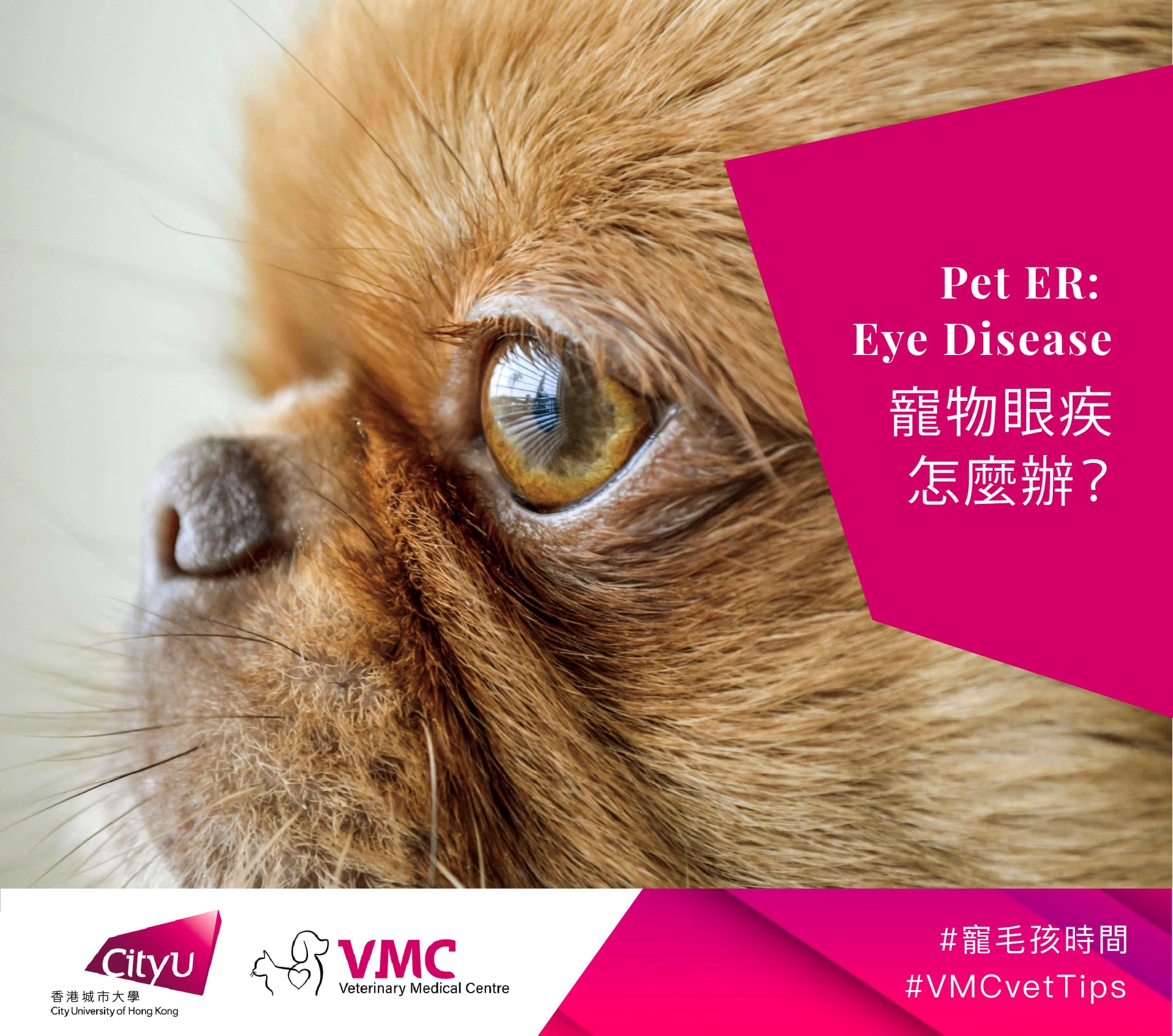CityU VMC Vets Tips! | Pet ER: Eye Disease
Aug 19, 2021
 There is an array of conditions that can happen to your pet’s eyes, some of them you might be able to notice through the daily care of your pets, while others can only be detected using diagnostic equipment. Certain eye conditions might also manifest as a change in behavior or your pet’s habit. But don’t be too worried, not all ocular changes are associated with disease process, some just come with life as your pet age. Although not all eye conditions are pathological, if you have noticed some changes to your pet’s eye, please do not just leave it without treatment as it might progress into something more serious or even vision loss.
What are the common eye diseases?
Ocular problems are one of the commonest reasons for a vet visit, many breeds are inherently prone to develop certain ocular diseases, for example:
Pugs – Corneal ulceration due to their brachycephalic breed nature and thick nasal folds
Welsh corgi – Tends to develop cataract at a later stage of life
Collie – Collie eye anomaly
Miniature and Toy poodle – Progressive retinal atrophy
Here is a list of some of the more common ocular diseases and etiologies
- Conjunctivitis – Inflammation of the soft tissue in-between the eyelid and the globe, common in cats usually with a mix of bacterial and viral infection; Allergic causes such as aerosols, or as part of atopic dermatitis in dogs
- Eye ulcers - a wound on the surface of the eye (the cornea) following physical trauma (eg fighting), through abrasion (eg nasal fold), or by infections (eg feline herpes virus)
- Dry eyes – deficiency in pre-corneal tear film
- Cherry eye – prolapse of the third eyelid gland
- Cataracts – defined as any opacity developed in the lens. It can be congenital, secondary to trauma, metabolic disease, inflammation, degeneration, or nutritional issues. This is different from nuclear sclerosis which is a normal aging process with the opacity on the lens appears more hazy and bluish than cataracts
- Glaucoma – increased intraocular pressure that can occur following inflammation, trauma, cataract, etc. Some breeds are prone to develop glaucoma. If left untreated, blindness can occur with 24 to 72 hours
Signs: how do you know your pet has eye issues?
If your pet has an issue with his/her eyes, you may notice the following signs:
• Redness of the sclera
• Discomfort
• Various types of ocular discharge
• Changes in the opacity of the eye such as on the corneal surface or in the lens
• Vision loss, Blindness at night
• Blood in the eye
Treatment
Topical and/or oral treatment might be dispensed to you by your veterinarian. Some ocular conditions will benefit from surgical treatment. Make sure you bring your pet for a consultation!
There is an array of conditions that can happen to your pet’s eyes, some of them you might be able to notice through the daily care of your pets, while others can only be detected using diagnostic equipment. Certain eye conditions might also manifest as a change in behavior or your pet’s habit. But don’t be too worried, not all ocular changes are associated with disease process, some just come with life as your pet age. Although not all eye conditions are pathological, if you have noticed some changes to your pet’s eye, please do not just leave it without treatment as it might progress into something more serious or even vision loss.
What are the common eye diseases?
Ocular problems are one of the commonest reasons for a vet visit, many breeds are inherently prone to develop certain ocular diseases, for example:
Pugs – Corneal ulceration due to their brachycephalic breed nature and thick nasal folds
Welsh corgi – Tends to develop cataract at a later stage of life
Collie – Collie eye anomaly
Miniature and Toy poodle – Progressive retinal atrophy
Here is a list of some of the more common ocular diseases and etiologies
- Conjunctivitis – Inflammation of the soft tissue in-between the eyelid and the globe, common in cats usually with a mix of bacterial and viral infection; Allergic causes such as aerosols, or as part of atopic dermatitis in dogs
- Eye ulcers - a wound on the surface of the eye (the cornea) following physical trauma (eg fighting), through abrasion (eg nasal fold), or by infections (eg feline herpes virus)
- Dry eyes – deficiency in pre-corneal tear film
- Cherry eye – prolapse of the third eyelid gland
- Cataracts – defined as any opacity developed in the lens. It can be congenital, secondary to trauma, metabolic disease, inflammation, degeneration, or nutritional issues. This is different from nuclear sclerosis which is a normal aging process with the opacity on the lens appears more hazy and bluish than cataracts
- Glaucoma – increased intraocular pressure that can occur following inflammation, trauma, cataract, etc. Some breeds are prone to develop glaucoma. If left untreated, blindness can occur with 24 to 72 hours
Signs: how do you know your pet has eye issues?
If your pet has an issue with his/her eyes, you may notice the following signs:
• Redness of the sclera
• Discomfort
• Various types of ocular discharge
• Changes in the opacity of the eye such as on the corneal surface or in the lens
• Vision loss, Blindness at night
• Blood in the eye
Treatment
Topical and/or oral treatment might be dispensed to you by your veterinarian. Some ocular conditions will benefit from surgical treatment. Make sure you bring your pet for a consultation!
Appointment/Enquiry: 3650 3000 (Mon-Sun: 9:00am – 7:00pm)
Address: G-2/F, Trinity Towers, 339 Lai Chi Kok Road, Sham Shui Po
Online booking for revisit with primary care veterinarians or vaccination: https://www.cityuvmc.com.hk/en/online-booking
Related products